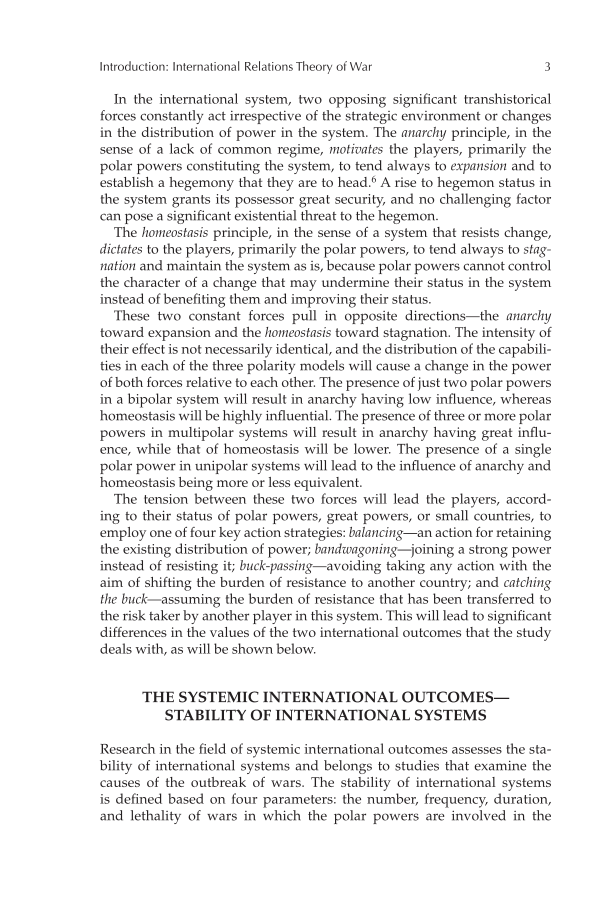Introduction: International Relations Theory of War 3 In the international system, two opposing significant transhistorical forces constantly act irrespective of the strategic environment or changes in the distribution of power in the system. The anarchy principle, in the sense of a lack of common regime, motivates the players, primarily the polar powers constituting the system, to tend always to expansion and to establish a hegemony that they are to head.6 A rise to hegemon status in the system grants its possessor great security, and no challenging factor can pose a significant existential threat to the hegemon. The homeostasis principle, in the sense of a system that resists change, dictates to the players, primarily the polar powers, to tend always to stag- nation and maintain the system as is, because polar powers cannot control the character of a change that may undermine their status in the system instead of benefiting them and improving their status. These two constant forces pull in opposite directions—the anarchy toward expansion and the homeostasis toward stagnation. The intensity of their effect is not necessarily identical, and the distribution of the capabili- ties in each of the three polarity models will cause a change in the power of both forces relative to each other. The presence of just two polar powers in a bipolar system will result in anarchy having low influence, whereas homeostasis will be highly influential. The presence of three or more polar powers in multipolar systems will result in anarchy having great influ- ence, while that of homeostasis will be lower. The presence of a single polar power in unipolar systems will lead to the influence of anarchy and homeostasis being more or less equivalent. The tension between these two forces will lead the players, accord- ing to their status of polar powers, great powers, or small countries, to employ one of four key action strategies: balancing—an action for retaining the existing distribution of power bandwagoning—joining a strong power instead of resisting it buck-passing—avoiding taking any action with the aim of shifting the burden of resistance to another country and catching the buck—assuming the burden of resistance that has been transferred to the risk taker by another player in this system. This will lead to significant differences in the values of the two international outcomes that the study deals with, as will be shown below. THE SYSTEMIC INTERNATIONAL OUTCOMES— STABILITY OF INTERNATIONAL SYSTEMS Research in the field of systemic international outcomes assesses the sta- bility of international systems and belongs to studies that examine the causes of the outbreak of wars. The stability of international systems is defined based on four parameters: the number, frequency, duration, and lethality of wars in which the polar powers are involved in the
Document Details My Account Print multiple pages
Print
You have printed 0 times in the last 24 hours.
Your print count will reset on at .
You may print 0 more time(s) before then.
You may print a maximum of 0 pages at a time.























































































































































































































































